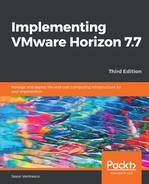Horizon Composer is used to provision linked-clone virtual desktops, which are a type of virtual machine that shares a common virtual desktop master image, sometimes referred to as a golden image. Horizon and vSphere support up to 4,000 desktops for each single replica of the virtual desktop master image, which enables significant storage savings over traditional full-clone virtual desktops.
The concept behind a linked-clone desktop is demonstrated in the following diagram, which shows the relationship between the master Replica Disk Read Only and the Linked-Clone Disk:

When a pool of linked-clone desktops is provisioned, a replica of the virtual desktop master image is copied to storage accessible by the Horizon ESXi servers. This replica will be used as a read-only copy of the virtual desktop master image; all writes are redirected to unique disks that are attached to each linked-clone. Linked-clones are provisioned using thin virtual disks, the configuration of which varies depending on the desktop pool settings.
The following diagram shows the configuration of two linked-clone virtual desktops that share the same virtual desktop master image:

In this diagram, each Linked-Clone Desktop is configured with optional disposable disks and persistent disks. Chapter 7, Creating Horizon Desktop Pools, explains the different options that affect the configuration of these and other linked-clone disks.
When the linked-clone desktops are powered on for the first time, they will begin redirecting any writes to the linked-clone disks and will also create a virtual swap (vswp) file of a size equal to the amount of unreserved virtual RAM (vRAM) allocated to the virtual machine.
Controlling the growth of a linked-clone desktop requires an understanding of multiple topics, all of which will be described within this book. The following chapters contain valuable information that can help you control the storage utilization of linked-clone desktops:
- Chapter 7, Creating Horizon Desktop Pools
- Chapter 9, Performing Horizon Pool Maintenance
- Chapter 10, Creating a Master Virtual Desktop Image
- Chapter 12, Implementing User Environment Manager
Horizon Composer works at the direction of the Horizon Connection Server to provision and manage linked-clone desktops. Horizon Composer uses the vSphere application program interface (API) to initiate whatever tasks are required based on the operation that is being performed. To achieve this, Horizon Composer requires specific permissions within vCenter Server, as well as permissions within Microsoft Active Directory, both of which will be described later in this chapter.
Horizon Clients do not come into contact with Horizon Composer; its role as an orchestration tool is to perform actions based on the configuration of the Horizon desktop pool. As such, Horizon Composer is depicted in the following architectural diagram as a stand-alone component that works directly with the vSphere and Horizon infrastructure:

The benefits of Horizon Composer do not start and end with gains in storage efficiency. The following features are just some of the ways with which you can leverage Horizon Composer to change how you manage desktop maintenance.
